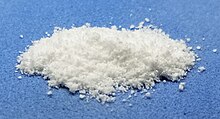Chemistry:β-Cyclodextrin

| |

| |
| Names | |
|---|---|
| IUPAC name
cyclomaltoheptaose
| |
| Systematic IUPAC name
cycloheptakis-(1→4)-α-D-glucopyranosyl | |
| Other names
Cycloheptaamylose
Cycloheptadextrin Cyclomaltoheptose β-Cycloamylose Schardinger β-Dextrin betadex | |
| Identifiers | |
| |
3D model (JSmol)
|
|
| ChEBI | |
| ChEMBL | |
| ChemSpider | |
| DrugBank | |
| EC Number |
|
| KEGG | |
PubChem CID
|
|
| UNII |
|
| |
| Properties | |
| C42H70O35 | |
| Molar mass | 1134.987 g·mol−1 |
| Appearance | white solid |
| Melting point | 501 °C (934 °F; 774 K) at fast heating rates, decomposition below 260 °C for conventional heating [1] |
| 18.5 g/L | |
Except where otherwise noted, data are given for materials in their standard state (at 25 °C [77 °F], 100 kPa). | |
| Infobox references | |
β-Cyclodextrin sometimes abbreviated as β-CD, is a heptasaccharide derived from glucose. The α- (alpha), β- (beta), and γ- (gamma) cyclodextrins correspond to six, seven, and eight glucose units, respectively. β-Cyclodextrin is the most used natural cyclodextrin in marketed medicines.[2] The reason for this lies in the ease of its production and subsequent low price (more than 10,000 tons produced annually with an average bulk price of approximately 5 USD per kg).
Structure
In β-cyclodextrin, the seven glucose subunits are linked end to end via α-1,4 linkages. The result has the shape of a tapered cylinder, with seven primary alcohols on one face and fourteen secondary alcohol groups on the other. The exterior surface of cyclodextrins is somewhat hydrophilic whereas the interior core is hydrophobic.
Physical properties
β-Cyclodextrin exists as a white (colorless) powder or crystals. The density of its saturated hydrate crystal (βCD·12H2O) is 1.46 g/cm3. β-Cyclodextrin is moderately soluble in water and glycerin; well soluble in dimethyl sulfoxide, dimethylformamide, pyridine, HFIP, and ethylene glycol; and insoluble in ethanol and acetone.[3]
Applications
β-Cyclodextrin is widely used in medicine, pharmacy, food industry, textiles. Its molecules can accommodate various biomolecules and hence are also used as a complexing agent.
Derivatives
β-cyclodextrin has relatively low solubility in water, and hence industry uses its derivatives, such as 2-hydroxypropyl-β-cyclodextrin (HPbCD), randomly methylated β-cyclodextrin (RAMEB), and β-cyclodextrin sulfobutyl ether sodium salt (SBEbCD).[4]
References
- ↑ Gatiatulin, Askar (2022), "Determination of Melting Parameters of Cyclodextrins Using Fast Scanning Calorimetry", Int. J. Mol. Sci. 23 (21): 13120, doi:10.3390/ijms232113120, PMID 36361919
- ↑ Kurkov, Sergey (2013), "Cyclodextrins", Int. J. Pharm. 453 (1): 167–180, doi:10.1016/j.ijpharm.2012.06.055, PMID 22771733
- ↑ Miranda, Janisse Crestani de (2011), "Cyclodextrins and ternary complexes: technology to improve solubility of poorly soluble drugs", Brazilian Journal of Pharmaceutical Sciences 47 (4): 665–681, doi:10.1590/S1984-82502011000400003
- ↑ Jansook, Phatsawee (2018), "Cyclodextrins: structure, physicochemical properties and pharmaceutical applications", Int. J. Pharm. 535 (1–2): 272–284, doi:10.1016/j.ijpharm.2017.11.018, PMID 29138045
 |

